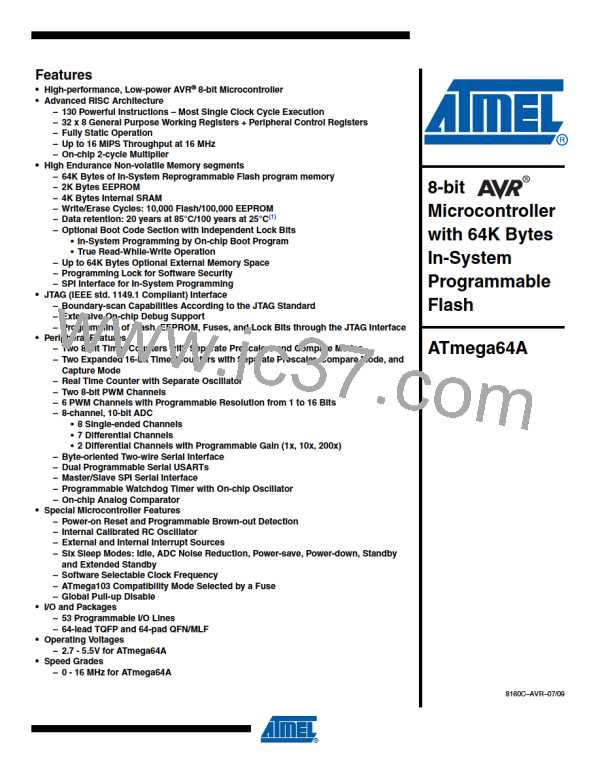ATmega64A
25.5.4
Scanning the Clock Pins
The AVR devices have many clock options selectable by fuses. These are: Internal RC Oscilla-
tor, External RC, External Clock, (High Frequency) Crystal Oscillator, Low-frequency Crystal
Oscillator, and Ceramic Resonator.
Figure 25-7 shows how each Oscillator with external connection is supported in the scan chain.
The Enable signal is supported with a general boundary-scan cell, while the Oscillator/clock out-
put is attached to an observe-only cell. In addition to the main clock, the timer Oscillator is
scanned in the same way. The output from the internal RC Oscillator is not scanned, as this
Oscillator does not have external connections.
Figure 25-7. Boundary-scan Cells for Oscillators and Clock Options
XTAL1/TOSC1
XTAL2/TOSC2
To
Next
Cell
To
ShiftDR
EXTEST
Next
Cell
Oscillator
ShiftDR
0
1
ENABLE
OUTPUT
0
1
FF1
D
Q
D
G
Q
0
1
D
Q
From
Previous
Cell
ClockDR UpdateDR
From
ClockDR
Previous
Cell
Table 25-3 summaries the scan registers for the external clock pin XTAL1, oscillators with
XTAL1/XTAL2 connections as well as 32 kHz Timer Oscillator.
Table 25-3. Scan Signals for the Oscillators(1)(2)(3)
Scanned Clock Line
Enable Signal
EXTCLKEN
OSCON
Scanned Clock Line
EXTCLK (XTAL1)
OSCCK
Clock Option
when Not Used
External Clock
0
0
External Crystal
External Ceramic Resonator
RCOSCEN
OSC32EN
TOSKON
RCCK
External RC
0
1
0
OSC32CK
TOSCK
Low Freq. External Crystal
32 kHz Timer Oscillator
Note:
1. Do not enable more than one clock source as main clock at a time.
2. Scanning an Oscillator output gives unpredictable results as there is a frequency drift between
the internal Oscillator and the JTAG TCK clock. If possible, scanning an external clock is
preferred.
3. The clock configuration is programmed by fuses. As a fuse does not change run-time, the
clock configuration is considered fixed for a given application. The user is advised to scan the
266
8160C–AVR–07/09

 ATMEL [ ATMEL ]
ATMEL [ ATMEL ]